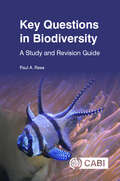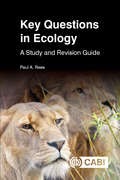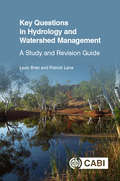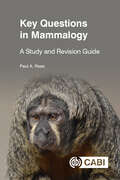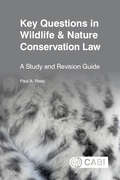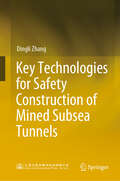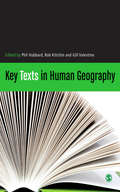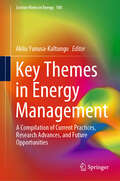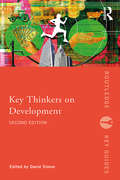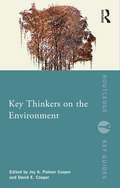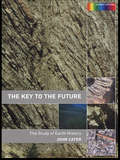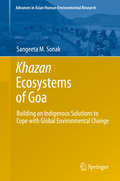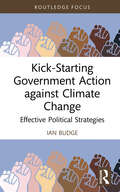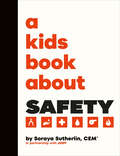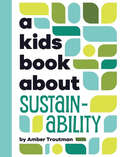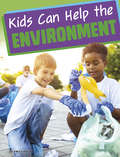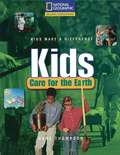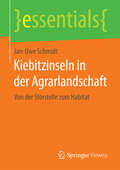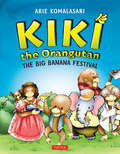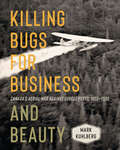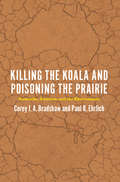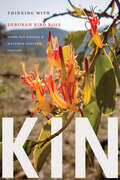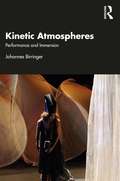- Table View
- List View
Key Questions in Biodiversity: A Study and Revision Guide (Key Questions)
by Dr Paul ReesAn understanding of biodiversity is an important requirement of a wide range of programmes of study including biology, zoology, wildlife conservation and environmental science. This book is a study and revision guide for students following such programmes in which biodiversity is an important component. It contains 600 multiple-choice questions (and answers) set at three levels - foundation, intermediate and advanced - and grouped into 10 major topic areas: 1. Principles of classification and taxonomy 2. Comparative anatomy and physiology 3. Protoctists, monerans, fungi, lichens and acellular organisms 4. 'Lower' plants and pteridophytes 5. Seed-bearing plants 6. Sponges, cnidarians, nematodes and minor animal phyla 7. Platyhelminths, annelids and molluscs 8. Arthropods and echinoderms 9. Fishes, amphibians and reptiles 10. Birds and mammals The book has been produced in a convenient format so that it can be used at any time in any place. It allows the reader to learn and revise the meaning of terms used in animal and plant classification, the principles of comparative physiology, and the characteristics of, and diversity in, the major animal and plant taxa. The structure of the book allows the study of one topic area or group of taxa at a time, progressing through simple questions to those that are more demanding. Many of the questions require students to use their knowledge to identify organisms and biological structures from drawings or photographs.
Key Questions in Ecology: A Study and Revision Guide (Key Questions)
by Dr Paul ReesAn understanding of ecology is an important requirement of a wide range of academic areas, including biology, zoology and environmental science. This book is a study and revision guide for students following programmes of study in which ecology is an important component. It contains 600 multiple-choice questions (and answers) set at three levels - foundation, intermediate and advanced - and grouped into 10 major topic areas: · The history and foundations of ecology · Abiotic factors and environmental monitoring · Taxonomy and biodiversity · Energy flow and production ecology · Nutrient and material cycles · Ecophysiology · Population ecology · Community ecology and species interactions · Ecological genetics and evolution · Ecological methods and statistics The book has been produced in a convenient format so that it can be used at any time in any place. It allows the reader to learn and revise the meaning of ecological terms, the basic processes operating in ecosystems, the dynamics of populations, ecological genetics and the process of evolution, the methods used in ecological surveys, and much more. The structure of the book allows the study of one topic area at a time, progressing through simple questions to those that are more demanding. Many of the questions require students to use their knowledge to interpret information provided in the form of graphs, data or photographs, providing a useful tool for independent study.
Key Questions in Hydrology and Watershed Management: A Study and Revision Guide (Key Questions)
by Professor Leon Bren Professor Patrick LaneThis book provides a series of exercises of various types covering matters of hydrology and watershed management. The exercises include true/false questions, multiple choice questions, and numeric, graphical, and analytical exercises. The questions draw on the basic disciplines of hydrology and physics, with some stress placed on correct or appropriate units. The questions reflect the authors' many years of teaching watershed management at undergraduate and graduate levels. Questions cover: 1. Terminology and measurement of flow (and units) 2. Quantifying stream networks 3. Concepts of water balance and evapotranspiration 4. Slope recharge, groundwater hydrology, and water-table/phreatic aquifers 5. Single and paired watershed experiments 6. Impacts of fires on watersheds 7. Concepts and measurements of water quality 8. Flooding forests 9. Valuation of water 10. Protection of forest stream by buffers 11. Urban watershed concepts The book is self-contained, and designed to be used at any time in any place, either for revision or as source material for teaching. The work is graded so that easier questions are presented early, followed by harder questions. Answers are concise but contain enough information to help students study and revise on a topic-by-topic basis. The book concludes with suggestions for student exercises and projects and is an invaluable resource for both students and instructors.
Key Questions in Mammalogy: A Study and Revision Guide (Key Questions)
by Dr Paul ReesAlthough mammals comprise a relatively small proportion of total biodiversity they are disproportionately represented in courses in biology and zoology and they are the dominant taxon in zoos around the world. Mammalogy is well-established as a discrete element of biological courses in some parts of the world, notably in North America. This book is intended as a study and revision guide for students following programmes of study in which mammalogy is an important component. It comprises 600 multiple-choice questions (and answers) set at three levels - foundation, intermediate and advanced - grouped into 10 major topic areas: 1. The history and principles of mammalogy 2. Origins, evolution and taxonomy 3. Anatomy 4. Physiology 5. Behaviour 6 Ecology and genetics 7. Zoogeography 8. Conservation and management 9. Parasites and diseases 10. Domestication and human use of animals The book is designed to be used at any time in any place. It allows the reader to study the meaning of terms used in mammalogy, the history of mammalogy, the taxonomy, evolution and genetics of mammals, their zoogeography, their anatomy, physiology and adaptations to their environment, their behaviour, their conservation and management, their diseases, and their domestication and use by humans. Some of the questions will require students to use their knowledge to interpret information provided in the form of graphs, data, maps or photographs
Key Questions in Wildlife & Nature Conservation Law: A study and revision guide (Key Questions)
by Dr Paul ReesLaw plays an essential part in the conservation of wildlife and ecosystems. The study of wildlife and nature conservation law is an important component of a wide range of programmes of study including wildlife conservation, environmental management and environmental law. This book is a study and revision guide for students following such programmes. It contains 600 multiple choice questions (and answers) set at three levels - foundation, intermediate and advanced - and grouped into 10 major topic areas: 1. Principles of Wildlife and Nature Conservation Law 2. History of Wildlife and Nature Conservation Law 3. Species Protection and Exploitation I - EU and International Law 4. Species Protection and Exploitation II - National Laws 5. Protected Areas and Habitats I - EU and International Laws 6. Protected Areas and Habitats II - National Laws 7. Planning, Pollution, Restoration and Conservation Funding 8. Wildlife Trade, Animal Collections and Alien Species 9. Wildlife Law Enforcement and Penalties 10. Legal Texts This book has been produced in a convenient format so that it can be used at any time, in any place. It allows the reader to learn and revise the meaning of terms used in wildlife and nature conservation law and study the role of legislation at national, European Union (EU) and international level in the protection of individual species, habitats and landscapes. It uses examples from a wide variety of taxa, habitats and protected areas selected from a range of jurisdictions from the United Kingdom, the United States and Australia to Antarctica and the High Seas. Topics include the control of hunting, the conservation of trees and forests, the protection of National Parks and wilderness areas, wildlife trade and the organisations involved in the enforcement of wildlife laws. The structure of the book allows the study of one topic area at a time, progressing through simple questions to those that are more demanding. Some of the questions require students to use their knowledge to interpret information provided in the form of photographs and legal texts.
Key Technologies for Safety Construction of Mined Subsea Tunnels
by Dingli ZhangThis book puts forward a technological system for the construction of subsea tunnel using drilling and blasting method. Taking the water-induced disaster as the core risk, the safety guarantee system for large cross-sectional subsea tunnels is established. The composite grouting technology referred to ground reinforcement and water plugging is established, which breaks through the technical bottleneck of subsea tunnel construction in highly permeable strata. The process control theory based on water inrush mechanism is created, which gets rid of the over-dependence on engineering experience for disaster control of submarine tunnel. An active control waterproof drainage system based on the synergy of reinforcement ring and support system is invented to solve the contradiction between the control of water displacement and water pressure. The above-mentioned achievements have been successfully applied in the first three large cross-sectional subsea tunnels in China, and have played a key role in the construction safety. The proposed technological system can improve the overall construction level of subsea tunnel, which can provide reference for the design and construction of subsea tunnels, especially for those crossing through weakness zones.
Key Texts in Human Geography
by Gill Valentine Rob Kitchin Dr Phil Hubbard"A book that will delight students... Key Texts in Human Geography is a primer of 26 interpretive essays designed to open up the subject's landmark monographs of the past 50 years to critical interpretation... The essays are uniformly excellent and the enthusiasm of the authors for the project shines through... It will find itself at the top of a thousand module handouts." - THE Textbook Guide "Will surely become a 'key text' itself. Read any chapter and you will want to compare it with another. Before you realize, an afternoon is gone and then you are tracking down the originals." - Professor James Sidaway, University of Plymouth 'An essential synopsis of essential readings that every human geographer must read. It is highly recommended for those just embarking on their careers as well as those who need a reminder of how and why geography moved from the margins of social thought to its very core." - Barney Warf, Florida State University Undergraduate geography students are often directed to 'key' texts in the literature but find them difficult to read because of their language and argument. As a result, they fail to get to grips with the subject matter and gravitate towards course textbooks instead. Key Texts in Human Geography serves as a primer and companion to the key texts in human geography published over the past 40 years. It is not a reader, but a volume of 26 interpretive essays highlighting: the significance of the text how the book should be read reactions and controversies surrounding the book the book's long-term legacy. It is an essential reference guide for all students of human geography and provides an invaluable interpretive tool in answering questions about human geography and what constitutes geographical knowledge.
Key Themes in Energy Management: A Compilation of Current Practices, Research Advances, and Future Opportunities (Lecture Notes in Energy #100)
by Akilu Yunusa-KaltungoThis book provides a comprehensive global coverage of energy management as it relates mostly to developing countries. In an era of unprecedented global population growth, the demand for energy has reached staggering levels. The United Nations reported an enormous 200% increase in population between 1950 and 2020, with projections indicating a further rise to 10.9 billion by 2100. As a direct consequence, global primary energy usage has surged from 3701 Mtoe in 1965 to 13511 Mtoe in 2017, putting immense strain on existing energy sources. If current growth rates persist, these sources could be depleted within a mere 130 years. To address this impending crisis, governments worldwide have implemented regulations and incentives to promote energy conservation. While numerous studies and publications have emerged within the field of energy management, there remains a significant research gap, particularly concerning the energy challenges faced by developing countries. Existing edited books on energy-related topics often narrowly focus on specific aspects, hindering readers from gaining a holistic understanding of energy management challenges and potential solutions. This book fills this void. Recognizing the pivotal role these nations play in achieving sustainable development goals, this book provides a wide-ranging perspective on the trends, challenges, and potential solutions to energy crises in these regions. It not only acknowledges the challenges faced by developing countries but also offers viable strategies to address them. The editor, leveraging his successful leadership experience in global academic endeavors, including publishing a book on Occupational Safety & Health practices during the COVID-19 era and coordination of multinational research projects, is well positioned to bring together exceptional chapters from various countries. His extensive network ensures the inclusion of diverse perspectives, enriching the book's content and offering invaluable insights to readers. Designed for a broad readership, including energy industry organizations, professionals, researchers, government bodies, policymakers, and students, this book delves into a wide array of energy management issues. By facilitating a comprehensive understanding of the subject, it equips readers with the knowledge and tools necessary to navigate the complex landscape of energy management in the modern world.
Key Thinkers on Development (Routledge Key Guides)
by David SimonSince its publication in 2006 as Fifty Key Thinkers on Development, this invaluable reference has established itself as the leading biographical handbook in its field, providing a concise and accessible introduction to the lives and key contributions of development thinkers from across the ideological and disciplinary spectrum. This substantially expanded and fully updated second edition in the relaunched series without the numerical constraint includes an additional 24 essays, filling in many gaps in the original selection, greatly improving the gender balance and diversifying coverage to reflect the evolving landscape of development in theory, policy and practice. It presents a unique guide to the lives, ideas and practices of leading contributors to the contested terrain of development studies and development policy and practice. Its thoughtful essays reflect the diversity of development in theory, policy and practice across time, space, disciplines and communities of practice. Accordingly, it challenges Western-centrism, Orientalism and the like, while also demonstrating the enduring appeal of "development" in different guises. David Simon has assembled a highly authoritative team of contributors from different backgrounds, regional settings and disciplines to reflect on the lives and contributions of leading authorities on development from around the world. These include: Modernisers like Kindleberger, Perroux and Rostow Dependencistas such as Frank, Furtado, Cardoso and Amin Progressives and critical modernists like Hirschman, Prebisch, Helleiner Sen, Streeten and Wang Political leaders enunciating radical alternative visions of development, such as Mao, Nkrumah and Nyerere Progenitors of religiously or spiritually inspired development, such as Gandhi, Ariyaratne and Vivekananda Development–environment thinkers like Agarwal, Blaikie, Brookfield, Ostrom and Sachs International institution builders like Singer, Hammarsköld, Kaul and Ul Haq Anti- and post-development thinkers and activists like Escobar, Ghosh, Quijano and Roy Key Thinkers on Development is therefore the essential handbook on the world’s most influential development thinkers and an invaluable guide for students of development and sustainability, policy-makers and practitioners seeking an accessible overview of this diverse field and its leading voices.
Key Thinkers on the Environment (Routledge Key Guides)
by David E. Cooper Joy A. Palmer CooperKey Thinkers on the Environment is a unique guide to environmental thinking through the ages. Joy A. Palmer Cooper and David E. Cooper, themselves distinguished authors on environmental matters, have assembled a team of expert contributors to summarize and analyse the thinking of diverse and stimulating figures from around the world and from ancient times to the present day. Among those included are: philosophers such as Rousseau, Kant, Spinoza and Heidegger activists such as Chico Mendes and Wangari Maathai literary giants such as Virgil, Goethe and Wordsworth major religious and spiritual figures such as Buddha and St Francis of Assissi eminent scientists such as Darwin, Lovelock and E.O. Wilson. Lucid, scholarly and informative, the essays contained within this volume offer a fascinating overview of humankind’s view and understanding of the natural world.
Key to The Future: The History of Earth Science
by John CaterHere is a book for everyone who has an interest in how our planet works, what has happened during its 4,550 million year history and what might happen in the future. It tells how Earth scientists study the pattern of events that have shaped the planet and guided the evolution of life on Earth. In clear and simple language it describes how the effec
Khazan Ecosystems of Goa
by Sangeeta M. SonakThis book elaborates on the Khazan ecosystems of Goa, India. Khazans are human-managed ecosystems, which are reclaimed from coastal wetlands, salt marshes and mangrove areas, where tidal influence is regulated through a highly structured system of dykes, canals, furrows, and sluice gates using resources that are amply available locally. Khazan ecosystems are marvels of tribal engineering. They are a simple architectural design, which operate at a very low running cost using tidal, hydro, and solar energy. The design contributes to a highly complex but eco-friendly ecosystem integrating agriculture, aquaculture and salt panning. . Khazan ecosystems have been functional for the last 3500 years. The history of Khazans is very ancient and can be traced to the transition from food gathering to food growing, which has been regarded as the biggest step in the history of human civilization. Khazan ecosystems thus have a high historical and world heritage value. They are also repositories of global biodiversity, with unique flora suitable to their unique and highly variable environment. They are endemic and heritage ecosystems of Goa and ultimately reservoirs of history and heritage. Using the example of the Khazan lands, the book analyzes and comments on traditional ecological knowledge and indigenous technology. It presents the evolution of Khazan management institutions over a period of more than three thousand years, as well as factors that have contributed to its decline in recent years It develops a conceptual framework for ecosystem performance and suggests strategies for conservation of Khazans as well as strategies to build on these indigenous adaptation mechanisms to cope with the global environmental change.
Kick-Starting Government Action against Climate Change: Effective Political Strategies (Routledge Advances in Climate Change Research)
by Ian BudgeWith drastic action needing to be taken now, rather than over the 30 years to 2050, this book addresses the crucial question of how to get action from governments who will always put short-term considerations (e.g. post Covid economic growth) over longer term climate priorities – unless forced to do otherwise. How might governments be persuaded to implement policies that will result in effective action? And how can this be achieved at an international, as well as national, level? These are the questions that this book focuses on. Taking a systematic political science point of view and drawing on collective choice and other theories of political action, this book analyses the key political and economic dynamics shaping climate policies around the world, identifying major political opportunities that can be exploited by well-informed and determined political actors, such as NGOs and social movements. This book describes how to advance and accelerate climate action around the world and will be of interest internationally to climate change campaigners, activists, political and environmental scientists.
Kids Book About Safety, A (A Kids Book)
by Soraya SutherlandThis book empowers kids through a simple, step-by-step plan to keep them and their families safe during potential emergency situations.What would you do if an earthquake happened? How about a house fire? Or maybe a tornado? Emergency situations can be scary to think about, but we can feel confident and empowered in dangerous situations if we do one simple thing: be prepared! This book shows kids that by knowing what disasters could happen, and what to do if they occur, makes you ready and can even save lives.
Kids Book About Sustainability, A (A Kids Book)
by Amber TroutmanWe can all choose sustainable practices today to improve the health of our planet for ourselves and future generations!Sustainability is a long word that simply means to live on this Earth in a responsible way. We do this for ourselves, for all fellow inhabitants, current and future, and for the planet itself. Open this book and learn the good and not-so-good impact our actions have on the Earth. And, importantly, how we can start living sustainably today. Lasting change takes time, and our choices really matter!
Kids Can Help the Environment (Kids Can Help)
by Emily RaijMake the world a cleaner, healthier place to live! This book is full of ideas and projects readers can put into action to help the environment.
Kids Care for the Earth
by Gare ThompsonKids do care for Mother Earth. See how they plan projects, clean up the environment and reuse and recycle resources.
Kiebitzinseln in der Agrarlandschaft: Von der Störstelle zum Habitat (essentials)
by Jan-Uwe SchmidtIn diesem essential beschreibt Jan-Uwe Schmidt, wie durch Kiebitzinseln nicht nur dem Kiebitz geholfen wird, sondern auch andere Tier- und Pflanzenarten profitieren k#65533;nnen. Durch j#65533;hrliche Anlage einer Schwarzbrache mit mindestens 2 Hektar Gr#65533;#65533;e lassen sich Nassstellen leicht als Kiebitzbrutplatz einrichten. Landwirte erh#65533;hen so die Nachhaltigkeit der Landnutzung und schaffen au#65533;erdem einen sicheren Erl#65533;s aus der Verg#65533;tung der Agrarumweltma#65533;nahme. Dieses essential gibt praktische Hinweise zur Planung und Anlage von Kiebitzinseln mithilfe von Luftbildern.
Kiki the Orangutan
by Arie KomalasariKiki is bored. And hungry! His family is busy, he wants to play, but no one has the time. So Kiki goes for a walk...and that's where all the trouble begins!Kiki the Orangutan is the charming tale of a naughty but good-natured orangutan who simply cannot resist stealing a bunch of ripe bananas from his neighbor's tree. After he has eaten them, however, he finds out that the bananas were going to be used to make banana bread-his favorite food-for the Banana Festival the next day. Now his poor neighbor has no bananas left to make any bread! Can Kiki make up for his actions and find a new bunch of bananas in time?
Kill the Cowboy: A Battle of Mythology in the New West
by Sharman Apt RussellOn ranching, environmentalism, and change -- life and thought in the West, seen through the eyes of some of the players.
Killing Bugs for Business and Beauty: Canada’s Aerial War against Forest Pests, 1913–1930
by Mark KuhlbergKilling Bugs for Business and Beauty examines the beginning of Canada’s aerial war against forest insects and how a tiny handful of officials came to lead the world with a made-in-Canada solution to the problem. Shedding light on a largely forgotten chapter in Canadian environmental history, Mark Kuhlberg explores the theme of nature and its agency. The book highlights the shared impulses that often drove both the harvesters and the preservers of trees, and the acute dangers inherent in allowing emotional appeals instead of logic to drive environmental policy-making. It addresses both inter-governmental and intra-governmental relations, as well as pressure politics and lobbying. Including fascinating tales from Cape Breton Island, Muskoka, and Stanley Park, Killing Bugs for Business and Beauty clearly demonstrates how class, region, and commercial interest intersected to determine the location and timing of aerial bombings. At the core of this book about killing bugs is a story, infused with innovation and heroism, of the various conflicts that complicate how we worship wilderness.
Killing the Koala and Poisoning the Prairie: Australia, America, and the Environment
by Paul R. Ehrlich Corey J. A. BradshawThough separated by thousands of miles, the United States and Australia have much in common. Geographically both countries are expansive--the United States is the fourth largest in land mass and Australia the sixth--and both possess a vast amount of natural biodiversity. At the same time, both nations are on a crash course toward environmental destruction. Highly developed super consumers with enormous energy footprints and high rates of greenhouse-gas emissions, they are two of the biggest drivers of climate change per capita. As renowned ecologists Corey J. A. Bradshaw and Paul R. Ehrlich make clear in Killing the Koala and Poisoning the Prairie, both of these countries must confront the urgent question of how to stem this devastation and turn back from the brink. In this book, Bradshaw and Ehrlich provide a spirited exploration of the ways in which the United States and Australia can learn from their shared problems and combine their most successful solutions in order to find and develop new resources, lower energy consumption and waste, and grapple with the dynamic effects of climate change. Peppering the book with humor, irreverence, and extensive scientific knowledge, the authors examine how residents of both countries have irrevocably altered their natural environments, detailing the most pressing ecological issues of our time, including the continuing resource depletion caused by overpopulation. They then turn their discussion to the politics behind the failures of environmental policies in both nations and offer a blueprint for what must be dramatically changed to prevent worsening the environmental crisis. Although focused on two nations, Killing the Koala and Poisoning the Prairie clearly has global implications--the problems facing the United States and Australia are not theirs alone, and the solutions to come will benefit by being crafted in coalition. This book provides a vital opportunity to learn from both countries' leading environmental thinkers and to heed their call for a way forward together.
Killing the Koala and Poisoning the Prairie: Australia, America, and the Environment
by Paul R. Ehrlich Corey J. BradshawThough separated by thousands of miles, the United States and Australia have much in common. Geographically both countries are expansive—the United States is the fourth largest in land mass and Australia the sixth—and both possess a vast amount of natural biodiversity. At the same time, both nations are on a crash course toward environmental destruction. Highly developed super consumers with enormous energy footprints and high rates of greenhouse-gas emissions, they are two of the biggest drivers of climate change per capita. As renowned ecologists Corey J. A. Bradshaw and Paul R. Ehrlich make clear in Killing the Koala and Poisoning the Prairie, both of these countries must confront the urgent question of how to stem this devastation and turn back from the brink. In this book, Bradshaw and Ehrlich provide a spirited exploration of the ways in which the United States and Australia can learn from their shared problems and combine their most successful solutions in order to find and develop new resources, lower energy consumption and waste, and grapple with the dynamic effects of climate change. Peppering the book with humor, irreverence, and extensive scientific knowledge, the authors examine how residents of both countries have irrevocably altered their natural environments, detailing the most pressing ecological issues of our time, including the continuing resource depletion caused by overpopulation. They then turn their discussion to the politics behind the failures of environmental policies in both nations and offer a blueprint for what must be dramatically changed to prevent worsening the environmental crisis. Although focused on two nations, Killing the Koala and Poisoning the Prairie clearly has global implications—the problems facing the United States and Australia are not theirs alone, and the solutions to come will benefit by being crafted in coalition. This book provides a vital opportunity to learn from both countries’ leading environmental thinkers and to heed their call for a way forward together.
Kin: Thinking with Deborah Bird Rose
by Thom van Dooren and Matthew ChrulewThe contributors to Kin draw on the work of anthropologist Deborah Bird Rose (1946–2018), a foundational voice in environmental humanities, to examine the relationships of interdependence and obligation between human and nonhuman lives. Through a close engagement over many decades with the Aboriginal communities of Yarralin and Lingara in northern Australia, Rose’s work explored possibilities for entangled forms of social and environmental justice. She sought to bring the insights of her Indigenous teachers into dialogue with the humanities and the natural sciences to describe and passionately advocate for a world of kin grounded in a profound sense of the connectivities and relationships that hold us together. Kin’s contributors take up Rose’s conceptual frameworks, often pushing academic fields beyond their traditional objects and methods of study. Together, the essays do more than pay tribute to Rose’s scholarship; they extend her ideas and underscore her ongoing critical and ethical relevance for a world still enduring and resisting ecocide and genocide.Contributors. The Bawaka Collective, Matthew Chrulew, Colin Dayan, Linda Payi Ford, Donna Haraway, James Hatley, Owain Jones, Stephen Muecke, Kate Rigby, Catriona (Cate) Sandilands, Isabelle Stengers, Anna Tsing, Thom van Dooren, Kate Wright
Kinetic Atmospheres: Performance and Immersion
by Johannes BirringerThis book offers a sustained and deeply experiential pragmatic study of performance environments, here defined at unstable, emerging, and multisensational atmospheres, open to interactions and travels in augmented virtualities. Birringer’s writings challenge common assumptions about embodiment and the digital, exploring and refining artistic research into physical movement behavior, gesture, sensing perception, cognition, and trans-sensory hallucination. If landscapes are autobiographical, and atmospheres prompt us to enter blurred lines of a "forest knowledge," where light, shade, and darkness entangle us in foraging mediations of contaminated diversity, then such sensitization to elemental environments requires a focus on processual interaction. Provocative chapters probe various types of performance scenarios and immersive architectures of the real and the virtual. They break new ground in analyzing an extended choreographic – the building of hypersensorial scenographies that include a range of materialities as well as bodily and metabodily presences. Foregrounding his notion of kinetic atmospheres, the author intimates a technosomatic theory of dance, performance, and ritual processes, while engaging in a vivid cross-cultural dialogue with some of the leading digital and theatrical artists worldwide. This poetic meditation will be of great interest to students and scholars in theatre, performing arts as well as media arts practitioners, composers, programmers, and designers.
